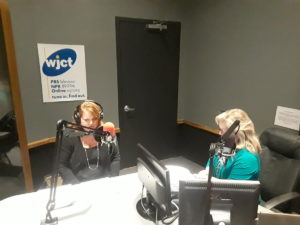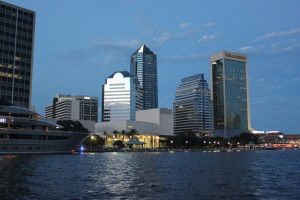
Reporter Lisa Grubba will be a guest on WJCT’s “First Coast Connect” to talk about her investigation into claims about Jacksonville’s drinking water quality. A national environmental group once listed the city as the tenth worst in the country for tap water quality.
But what data did it use and how accurate were its findings? Florida Field Notes investigated the claim and found some questions of its own.
Catch the show at 9:00 a.m.,Thursday, July 20, 2017, on 89.9 FM.
The original article is posted below.
Jacksonville, FL — An internet article listing Jacksonville’s drinking water the 10th worst in the U. S. got another round of sharing

and gasping on social media recently, even though the article is five years old and based on questionable data. But with some Flint residents sickened by their drinking water, the alarm is fresh.
AOL DailyFinance, a financial news blog, published the thinly-sourced article in 2011. An update in 2014 said the article’s only source, the Environmental Working Group (EWG), had admitted that for at least one utility, it had used the wrong data. EWG promised to update its database and the utility’s ranking, and AOL DailyFinance promised to update readers with EWG’s response to the error. To date, neither has happened.
Instead, “10 American Cities With the Worst Drinking Water” has circulated for five years and been picked up time and again in national and local media, driving viewers to AOL’s site and driving scared residents to buy bottled water and home filtration systems.
And guess who makes a profit off of that?
Not JEA, Jacksonville’s utility company who supplies water to most of northeast Florida.
JEA says the article is misleading and the test results misunderstood and misinterpreted.
“There is nothing about that [EWG] report that is accurate,” said Gerri Boyce, in media relations for JEA. “So we’re not going to respond to their numbers.”
EWG’s numbers came – not from independent testing, as some have thought – but from a compilation of publicly-available water sampling reports. The Safe Water Drinking Water Act requires utilities to perform water quality tests and report the results to state oversight agencies, in this case, the Florida Department of Environmental Protection (DEP).
EWG states in its 2009 report that it compiled 20 million results from 47,677 utilities into its database. It ranked the utilities by the total number of contaminants found without regard to the number of samples that were taken, which has been a consistent criticism of its methodology.
In Jacksonville, it identified a list of pollutants that it said “Exceed[s] Health Guidelines” and were “Over [the] Legal Limit.”
A University of West Florida study of the database said “Exceed[s] Health Guidelines” is a made-up category. The report was commissioned by Pensacola’s water authority after the EWG database ranked it the worst water quality in the nation. The UWF study said that category “is misleading, of their own creation, and has no regulatory or risk basis for use.”
The EWG database also said Jacksonville had one chemical, trihalomethanes, or THM, that tested “Over the Legal Limit” 12 times.
But that’s not the full story and that’s where it’s easy to scare consumers and mislead reporters.
More Than Meets the Eye
THMs are byproducts of chlorination. The EPA requires utilities to chlorinate water to kill disease-causing organisms, like the ones that caused cholera and typhoid a century ago. The EPA allows certain levels, but as all of the chemicals can fluctuate based on factors like temperature, it takes more than one sample to determine compliance.
“It’s based on a running annual average,” said Joni Petry, the DEP’s northeast district subject matter expert on drinking water quality.
For THMs, quarterly sampling results are averaged over a year, and if the average is above the EPA maximum level, then the utility is “out of compliance.”
And if JEA were out of compliance, then the DEP and the EPA would step in to take corrective action, said Russell Simpson, in media relations for the DEP.
“We are their watchdog,” he said.
EWG’s data for each utility is summarized in a chart that uses different terms than the EPA uses, reports individual samples rather than the average, and fails to note compliance at all. It does state in a footnote that “one test does not necessarily indicate that the system is out of compliance,” but no information is given for the individual utility it ranks.
Compliance was never mentioned in the DailyFinance article.
“That’s the big fallacy of that group,” said Simpson, referring to EWG. “They took one figure out of the ordinary that was high and ran with it.”
How Much is Too Much?
While there is no independent verification of the numbers in EWG’s database, JEA says there has “on occasion” been individual water samples where THM tested above the EPA level, said Tom Bartol, manager of Water Policy Compliance and Permitting at JEA.
He said that’s most likely to occur at points where water flushes out less often, like in rural areas, or new developments that aren’t yet built out and there’s less running of the pipes.
And when a level does test high?
“We deal with it,” Bartol said, by resampling, flushing out that system, or moving water from another part of the system.
He also said that, despite an individual test result, JEA has never been out of compliance.
“We are very fortunate to have a pristine source of water from the Floridan Aquifer that’s so pure we don’t have to do a lot of treatment,” Bartol said. “We take 45,000 samples a year. It’s very safe drinking water.”
But the DailyFinance article called the chemical compounds “toxic,” a word we didn’t see used in the EPA, Centers for Disease Control, World Health Organization, DEP, or JEA data on THMs.
Jacksonville University’s Dr. Lucinda Sonnenberg explained what makes a chemical toxic. Sonennberg has been an environmental chemist for 28 years and a professor of chemistry at Jacksonville University for 19 years.
“It’s important to keep results in the context of not only concentrations but also the duration of that concentration,” she said. “Something will be toxic not only by the dose but by how long a person is exposed to that dose. Almost any chemical can become toxic in high enough dosage. ”
Who defines safe dosage? The Environmental Protection Agency.
Dosage Over Time
The EPA set a maximum “allowable level” of THM of 80 parts per billion in 1998 after there were scientific studies of THM exposure causing cancer in laboratory rats.
It explains “parts per billion” in terms of ping pong balls and Olympic swimming pools. One part per billion is like one ping pong ball in an Olympic-sized swimming pool full of ping pong balls, according to the EPA.
It says a level of 100 ppb could result in one serious illness per 1,000,000 people drinking two liters of water a day for 70 years.
So if Jacksonville’s entire water supply (not just individual sample locations) contained 100 ppb of THMs everyday between now and when construction ends on I-95 (or the year 2086, whichever comes first), and every person drank 2 liters a day, one person has the potential to get cancer.
And that’s where other critics of the Environmental Working Group’s science come in.
“A Little Site of Horrors”
“The EWG report does not present a valid scientific assessment of water toxicity,” said the University of West Florida report. Its analysis of the EWG findings said the “rankings have little to no scientific validity” and the report was a “political campaign … done at the expense of public confidence.”
The water authority for Reno, Nevada found EWG looked at samples of raw water, not finished drinking water, which EWG later admitted, according to the DailyFinance article.
Dr. Josh Bloom, the Director of Chemical and Pharmaceutical PhD at the American Council on Science and Health, wrote on his blog at Science 2.0, that EWG is “perhaps the most scientifically flawed organization out there” which is “in the middle of a 14 year losing streak when it comes to getting anything scientifically correct.” He has criticized EWG for its “omission of one of the most important fundamentals of toxicology – … dose over time.” Bloom has a PhD in organic chemistry from the University of Virginia and was a National Institute of Health Post-doctoral Fellow at the University of Pennsylvania. He calls EWG’s website, where it has published toxicity alerts of numerous consumer products like sunscreen, crayons, and store receipts, a “little site of horrors.”
Get the Lead Out
The article said that lead and arsenic were in Jacksonville’s water at levels “exceeding health guidelines,” which, again, is the category the University of West Florida called “of their own creation.”
The database shows that neither lead nor arsenic ever tested above the EPA’s maximum level during the five year period.
If Jacksonville had “unhealthy levels” of lead and arsenic over the five year period of the report ending back in 2009, wouldn’t some community health problems have shown up? After all, in Flint, Michigan, it took no time for health issues to show up.
We called the Duval County Department of Health to see.
Charles Griggs, director of communications for Duval County Department of Health, said the department monitors reports to the state Bureau of Epidemiology and is aware of illnesses reported. He said Florida statute requires the medical community (labs, medical facilities, health service facilities, and some schools, nursing homes, and state institutions) to report certain diseases and conditions to the state, which it compiles into databases by county, and any member of the public can access (www.floridacharts.com).
Is there evidence of illness or conditions as a result of water quality problems in Duval County?
“Not that I’m aware of,” said Griggs.
In fact, the report shows ZERO cases of arsenic poisoning in Duval County for the years 2008 – 2014.
As for lead, Griggs said “The number of cases has basically been flat since 2002, as anyone can see on the database, and aren’t a significant amount of cases.” The cases wouldn’t necessarily come from water anyway, as Griggs said the big push was to get lead paint out of old homes in the area, which it did years back.
A further search of the database shows Jacksonville residents had influenza or pneumonia at four times the rate of lead poisoning. In fact, more adults had high blood cholesterol and weight problems than lead-related illnesses. And then there’s that really high outbreak: Chlamydia. While less than 4 in 100,000 reported lead-related illness, 640 in 100,000 had chlamydia.
Seems Jacksonville might be worried about filtering the wrong thing.
Follow the Money
Speaking of filters, we’re now back to the original question: Who benefits from EWG’s 2009 report?
The Environmental Working Group, a D.C. based non-profit that advocates for health and environmental issues, says in numerous places on its website, and in an interview with the Florida Times-Union back when the study came out, that they recommend water filters. Not bottled water, but water filters. It provides a guide to buying water filters on its website and a long list of products. Next to each product is a button that reads “Buy on Amazon.”
Its website says, “Shop through EWG’s special Amazon link and a portion of your total will go to EWG, at no cost to you, no matter what you buy.”
EWG also received corporate “sponsorships” from some of the companies whose product it “ranks,” like Stonybrook, whose yogurt they rank. And for a fee, EWG will evaluate a company’s product to see if it meets EWG’s standards to use the label “EWG Verified ™” on its product.
A far bigger percentage of its income, though, comes from private grants and individual donations. And in the four years after the water quality rankings came out, EWG’s revenue climbed from $3.5 million to $6.7 million, according to Activist Facts, a project of the Center for Organizational Research and Education.
As of press time, the Environmental Working Group has not yet responded to Florida Field Notes request for information. Interested readers can find the website at www.ewg.org.
AOL DailyFinance, who has kept the article on its site despite knowing about factual errors, is a site whose content appears to come from finance bloggers and other news organizations. It reports 3.9 million unique monthly visitors and 44 million monthly page views. No editor is listed, nor have they yet responded as of press time to a request for information on their editorial process on the article. It’s not known whether any staffers who may have worked on this article have science or environmental backgrounds.
The author of the article, Douglas McIntyre, wrote that a website called 24/7 Wall St. had “examined the quality of water supplies” based on EWG data and compiled the ranking. McIntyre is currently listed as CEO of 24/7 Wall St, a financial news site. As of press time, he has not responded to an email asking if he was employed by the site when he quoted them, or how many reporters worked on the data-intensive project, or what if any environmental or scientific backgrounds they may have had.
Putting it in Perspective
The Centers for Disease Control and the World Health Organization have both published papers on the health risk of THM in drinking water, and the CDC had this to say:
“[W]aterborne pathogens pose a real and more immediate threat to health; water disinfection byproducts are certainly the lesser of these two evils.”
Florida Field Notes will update this article as relevant new information is received. Reach us at editor@floridafieldnotes.com.
UPDATE 4/23/17: The original article by 24/7 Wall St. is no longer available. The title is still there, but the link to the article doesn’t work. The article can still be found on AOL Daily Finance and FFN will again try to contact an editor for the site.
Susan Cooper Eastman edited this article.
Christine Nichols copy edited versions of this article.


Leave a Reply